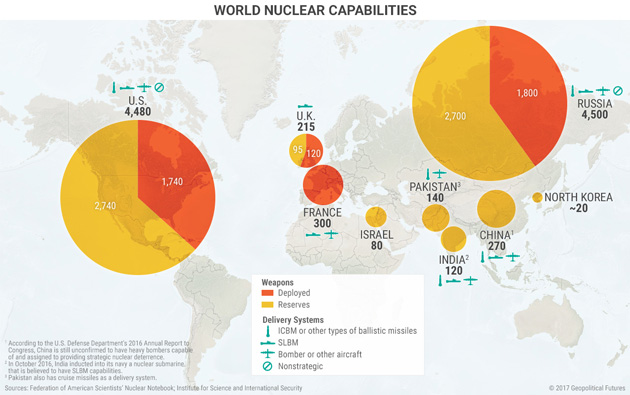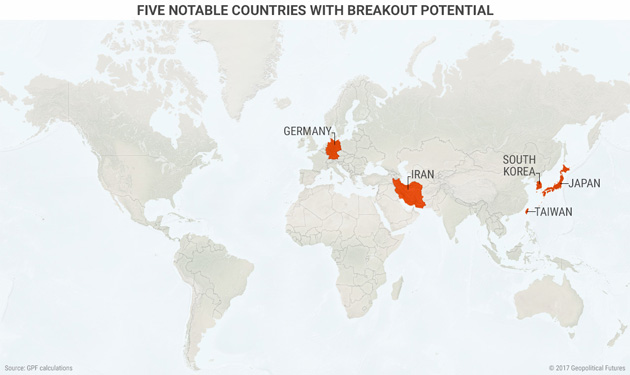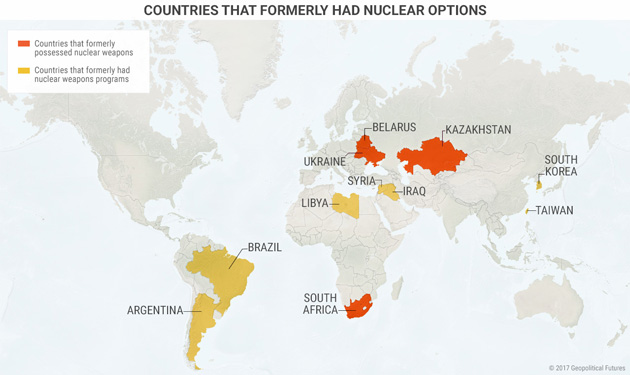April 17, 2017
The Geopolitics of Nuclear Weapons
By George Friedman, Xander Snyder, and Cheyenne Ligon
President Trump has reversed his stance on a number of foreign policy issues, including NATO, Russia, and China. This leaves citizens in the United States and worldwide more unsure than ever of what to expect from the coming months and years.
An Audio Pass from our conference, The Next 4 Years: The Role of the United States in the World will help shine a light through the fog of uncertainty. You can listen in to what leading geopolitical experts and people working at the heart of policy-making are forecasting—from how the United States will deal with North Korea to the future of Syria. Audio Passes are available through April 25 only—secure yours by clicking here.
Nuclear bombs have a strange quality: They are a type of weapon that countries spend enormous sums of money to develop but don’t actually intend to use. While chemical weapons have been frequently used in war, no country has detonated a nuclear bomb since the end of World War II.
Nuclear weapons are in their own category. Their efficacy comes from their ability to deter aggression, as the potential for massive devastation forces countries to rethink moves that threaten an adversary’s essential national security interests. States, therefore, are unlikely to use nuclear weapons against one another. However, the risk of a nuclear attack would increase if they were to fall into the hands of non-state actors that follow a different set of calculations that don’t necessarily take into account the defense of a predefined territory.
Nine countries currently have nuclear weapons with an assortment of delivery systems. The following graphics outline which countries possess or have possessed nuclear weapons, as well as some states capable of producing them. They also show how these weapons have reshaped the constraints that countries face in their geopolitical calculations.
Current Nuclear Powers
This map highlights three aspects of the global nuclear arsenal. The first is a distinction between deployed and reserve weapons. Deployed nuclear weapons are already attached to a delivery system and ready to use. Warheads in reserve still require this final attachment step before they can be delivered.
The second aspect is the three delivery systems that comprise the nuclear “triad”: land-based missiles (usually ballistic missiles but sometimes also cruise missiles), submarine-launched missiles (SLBMs), and weapons carried by aircraft (usually bombers but sometimes air-to-surface cruise missiles loaded on fighters or fighter-bombers). Land-based ballistic missiles—especially intercontinental ballistic missiles (ICBM)—provide long-range strike capability within a short period. SLBMs have retaliation capabilities in the event that a country’s land-based ballistic missile arsenal is destroyed in a first strike. Warheads on aircraft are more flexible, since bombers can be recalled after a strike has been ordered, but they are slower to reach their target than missiles (except in the case where bombers are already in flight and their target is nearby). Each nuclear country has a different mix of delivery capabilities, but only the Uni ted States and Russia are known to definitively possess a full triad, while China and India are suspected to have it.
The third aspect is the large portion of global nuclear arms held by the United States and Russia. Currently, the US has approximately 4,480 warheads, and Russia has 4,500. These figures include both strategic warheads (which are meant to strike sites located far from any hypothetical battlefield) and nonstrategic, or tactical, warheads (which are intended to be used near a battlefield, and as a result, are usually less powerful). The size of these arsenals, however, pales in comparison to each country’s peak inventory during the Cold War: The US had 31,255 in 1967, and the Soviet Union had 40,159 in 1986.
Throughout the Cold War, the doctrine of mutually assured destruction required a sufficiently large force that would allow for a massive retaliation even if a first strike eliminated a large portion of a country’s nuclear arsenal. Additionally, during most of the Cold War, delivery systems were not particularly accurate, which required that nuclear weapons have very large yields to reliably strike a target that might be located miles away from the point of detonation (many hydrogen bombs were in the several megaton range). As the accuracy of delivery systems improved, fewer nuclear warheads were required to maintain a credible deterrence threat, leading to a decline in both countries’ arsenals.
Nuclear weapons fundamentally alter the relations between countries because each country is forced to think more pointedly about its adversaries’ security imperatives. Developing a strong understanding of those imperatives is critical to avoiding a nuclear retaliation. While several “hot” wars and other tense moments occurred during the Cold War, none escalated to a direct confrontation between the Soviet Union and the US.
For a more recent example, consider the case of North Korea, which has received a lot of attention in the last week due to a recent missile test and the expectation of another nuclear test. It is a poor country whose nuclear program has allowed it to punch above its weight internationally and force superpowers to approach it with great caution. North Korea’s deterrent capability would be eliminated the moment it uses a nuclear weapon, which would be akin to committing certain suicide. While many fear the irrationality of North Korea’s leadership, Geopolitical Futures’ current understanding of the regime is that it has persisted for decades throughout the Cold War and after the fall of the Soviet Union because it is able to make cautious calculations and has continued to choose not to inflict destruction on itself.
Former Nuclear States
Note: While Iran appears to have discontinued its nuclear program in accordance with the Joint Comprehensive Plan of Action, we chose to include it in the third map to discuss the geopolitical ramifications of an Iranian nuclear breakout.
Several countries had nuclear weapons or weapons programs that were subsequently abandoned. Three factors contributed to these forfeitures: changes in geopolitical circumstances that decreased the need for nuclear deterrence, pressure from a major power that provided a guarantee under its own nuclear umbrella, and outside intervention that resulted in destruction of the weapons programs.
Belarus, Kazakhstan, and Ukraine all inherited nuclear weapons when the Soviet Union collapsed in 1991. Belarus was left in possession of 81 warheads and an assortment of nonstrategic nuclear weapons. Kazakhstan had 1,410 nuclear-tipped missiles. Ukraine was left with 1,900 strategic warheads and between 2,650 and 4,200 nonstrategic nuclear weapons, making it the third-largest nuclear arsenal in the world. All three countries signed the Nuclear Non-Proliferation Treaty (NPT) and returned the weapons to Russia by the mid-1990s to be dismantled.
South Africa is the only country that independently developed its nuclear weapons and subsequently forfeited them. The pro-apartheid government pursued nuclear energy and weapons development from the 1960s to the ’80s, eventually producing six nuclear weapons. In 1989, the program was stopped as apartheid came to an end and the government of F.W. de Klerk handed power over to the African National Congress. The weapons and associated facilities were dismantled, and South Africa signed the NPT in 1991.
Two developments influenced South Africa’s decision. A 1988 agreement between Cuba, Angola, and the US resulted in the withdrawal of 50,000 Cuban troops that had been stationed in Angola during the Cold War and supported by the Soviet Union. The risk of Soviet intervention posed by these troops in the ’70s was one of the main reasons South Africa developed nuclear capability in the first place. Second, South Africa weighed the costs and benefits of joining the NPT and realized that improved relations with the world more than offset the decreasing deterrent utility from the bomb since the Cuban forces had been withdrawn and the Soviet Union no longer posed a threat.
Argentina and Brazil are two of the seven other countries that abandoned their nuclear programs before acquiring nuclear weapons. They both secretly pursued nuclear weapons capability beginning in the late ’60s to early ’70s. By the early ’90s, both countries had given up their weapons programs and signed the NPT.
South Korea and Taiwan had secret nuclear programs in the ’70s that were discovered by international intelligence. Both programs were subsequently disbanded—South Korea’s in 1975 when it signed the NPT, and Taiwan’s in 1988 as a result of diplomatic pressure from the US.
In the Middle East and North Africa, Iraq, Syria, and Libya all had active nuclear weapons programs. Iraq’s nuclear program was forcibly dismantled after the Gulf War, and Libya voluntarily gave up its secret nuclear program in 2003 under the direction of Moammar Gadhafi. Syria’s nuclear ambitions never progressed as far as those of its neighbors, but it is believed to have possessed enriched uranium and built a research reactor with the aid of North Korea. In 2007, Israeli airstrikes took out Syria’s reactor, suspending the nuclear program indefinitely.
Nuclear Latency
When a country does not currently have nuclear weapons but has a peaceful nuclear program that could be used to produce nuclear weapons, it is said to be in a state of “nuclear latency.” To build a nuclear weapon, a country must have technical knowledge and capabilities, access to materials, and a well-developed industrial sector. Of the 31 countries that possess nuclear power plants, we have identified five important countries for which the acquisition of nuclear weapons would radically impact relations with both their regional neighbors and global powers. These countries have both the technological and economic resources to develop nuclear weapons and are likely to play pivotal roles in major geopolitical events within the next decade.
Iran’s nuclear ambitions led to intense negotiations with the West. In 2015, the negotiations resulted in the signing of the Joint Comprehensive Plan of Action (JCPOA), which saw Iran shelve its nuclear program for a set period of time in exchange for benefits including sanctions relief. However, if Iran were to continue enriching uranium in secret and develop a nuclear weapon despite the JCPOA, it would alter the balance of power in the region. Iran would have a new, asymmetric power relative to its Sunni rivals and force Israel to reconsider strategies that incorporate pre-emptive strikes.
Japan has large stockpiles of plutonium from civilian uses and already possesses uranium enrichment and plutonium reprocessing technologies. Estimates of Japan’s breakout time range from six months to several years. Japan’s alliance with the United States has thus far deterred it from developing nuclear weapons because it knows it can rely on the US for defense. However, North Korea’s progress in its nuclear program could drive Japan to reconsider. A nuclear Japan would threaten China’s desired hegemony in the region and force it to proceed with greater caution in its actions in the South China and East China seas.
South Korea and Taiwan have advanced civilian nuclear programs and technical knowledge that could be redirected into a weapons program. They also have the need to defend against regional threats. As North Korea appears to move closer to possessing a deliverable nuclear warhead, the South Korean government has debated acquiring a nuclear weapon. Taiwan is in a similar position. Its sovereignty is threatened by mainland China, which possesses nuclear weapons. Taiwan could consider developing a nuclear weapon to discourage Chinese aspirations to fully reclaim the island. South Korea and Taiwan are concerned about escalation, however, so instead choose to rely on the nuclear guarantee provided by their alliance with the US.
On the other side of the world is Germany. Germany is a highly industrialized state with civilian nuclear capabilities. It is currently protected under the NATO nuclear umbrella by the US and the European nuclear powers (France and the United Kingdom). It also is bound by international treaty not to pursue weapons development. However, it is not inconceivable that Germany would consider developing nuclear weapons to deter Russian aggression if it questioned America’s commitment.
Conclusion
Every country has a red line, past which its security imperatives will be threatened and it will be compelled to respond with force. Without a sufficient deterrent, potential adversaries incur less risk when they test where exactly that line is. Introducing nuclear weapons into these calculations, however, forces the aggressor to proceed with caution because the risk of massive retaliation is great. This is a difficult balance to strike when the addition of nuclear weapons by one party is itself the act that breaches the security imperatives of the other.
The world’s eyes are now set on North Korea for this reason: The United States is in the process of deciding whether recent developments in North Korea’s nuclear program have crossed this boundary and, if they have, what force constitutes an appropriate response. Though the US is not directly threatened by North Korea’s nuclear weapons (based on the current understanding of its ballistic missile technology), the safety of its allies would be jeopardized by a North Korean bomb. British and French fears that the US would not make good on its nuclear guarantee led to proliferation in Europe. Similarly, if the US’s Asian allies question the credibility of its guarantee, the risk of nuclear proliferation in the region will grow.
 George Friedman Editor, This Week in Geopolitics |
ROILO GOLEZ, Philippine National Security Adviser (2001-2004). The world and the Philippines as Roilo Golez sees it. With focus on national security, geopolitics, geo-security, economics, science and government.
Monday, April 17, 2017
Nuclear Powers of the World. George Friedman
Subscribe to:
Post Comments (Atom)

No comments:
Post a Comment